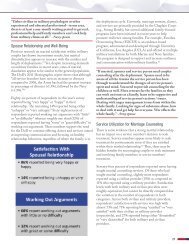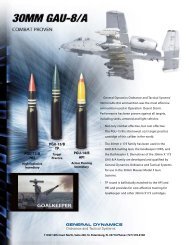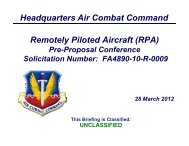F-35 Joint Strike Fighter (JSF) - WordPress.com
F-35 Joint Strike Fighter (JSF) - WordPress.com
F-35 Joint Strike Fighter (JSF) - WordPress.com
You also want an ePaper? Increase the reach of your titles
YUMPU automatically turns print PDFs into web optimized ePapers that Google loves.
DOD PROGRAMS<br />
Mission Systems<br />
Flight Test Activity with AF-3, AF-6, AF-7, BF-17, and BF-18<br />
Test Aircraft and Software Development Progress<br />
• Mission systems are developed and fielded in incremental<br />
blocks of capability.<br />
--<br />
Block 1. The program designated Block 1 for initial<br />
training capability and allocated two increments:<br />
Block 1A for Lot 2 (12 aircraft) and Block 1B for Lot 3<br />
aircraft (17 aircraft). No <strong>com</strong>bat capability is available in<br />
either Block 1 increment. (Note: Remaining development<br />
and testing of Block 0.5 initial infrastructure was absorbed<br />
into Block 1 during the program restructuring in 2011.)<br />
--<br />
Block 2A. The program designated Block 2A for<br />
advanced training capability and associated this block<br />
with Lots 4 and 5. No <strong>com</strong>bat capability is available in<br />
Block 2A.<br />
--<br />
Block 2B. The program designated Block 2B for initial,<br />
limited <strong>com</strong>bat capability for selected internal weapons<br />
(AIM-120C, GBU-32/31, and GBU-12). This block<br />
is not associated with the delivery of any production<br />
aircraft. Block 2B software will be used to retrofit earlier<br />
production aircraft.<br />
--<br />
Block 3i. Block 3i is Block 2A capability re-hosted on an<br />
improved integrated core processor for Lots 6 through 8.<br />
--<br />
Block 3F. The program designated Block 3F as the full<br />
SDD capability for production Lot 9 and later.<br />
• The Patuxent River test site accepted two early production<br />
aircraft from Lot 3 (BF-17 and BF-18) to support mission<br />
systems development and testing, in accordance with<br />
guidance following the Technical Baseline Review (TBR) in<br />
October 2010. Aircraft BF-17 ferried to Patuxent River on<br />
October 4th and BF-18, on November 8th. BF-17 began radar<br />
signature testing soon after arrival; BF-18 has yet to fly test<br />
sorties.<br />
• The four mission systems flight test aircraft, three assigned<br />
to the Edwards AFB test center, and one BF-17 assigned<br />
to Patuxent River, flew an average rate of 5.0 sorties per<br />
aircraft per month through November, exceeding the planned<br />
rate of 4.4 by 14 percent. Mission systems test aircraft flew<br />
115 percent of the test flights planned through the end of<br />
November (222 sorties <strong>com</strong>pleted <strong>com</strong>pared to 193 planned).<br />
• The test team ac<strong>com</strong>plished 95 percent of the planned 2012<br />
baseline test points by the end of November (1,238 baseline<br />
test points ac<strong>com</strong>plished, 1,308 planned). The team also<br />
ac<strong>com</strong>plished an additional 610 test points for regression<br />
testing of additional revisions of Block 2A software.<br />
Mission Systems Assessment<br />
• The program made limited progress in 2012 in fielding<br />
capability, despite relatively high sortie and test point<br />
<strong>com</strong>pletion rates.<br />
--<br />
Software delivery to flight test was behind schedule or not<br />
<strong>com</strong>plete when delivered.<br />
▪ ▪ Block 1 software has not been <strong>com</strong>pleted; approximately<br />
20 percent of the planned capability has yet to be<br />
integrated and delivered to flight test.<br />
▪ ▪ The first version of Block 2A software was delivered<br />
four months late to flight test. In eight subsequent<br />
versions released to flight test, only a limited portion<br />
of the full, planned Block 2A capability (less than<br />
50 percent) became available and delivered to<br />
production. Block 2A has no <strong>com</strong>bat capability.<br />
▪ ▪ Block 2B software was planned to be delivered to flight<br />
test by the end of 2012, but less than 10 percent of the<br />
content was available for integration and testing as of<br />
the end of August. A very limited Block 1B software<br />
version was delivered to the Cooperative Avionics Test<br />
Bed aircraft in early November for integration testing.<br />
▪ ▪ The program made virtually no progress in the<br />
development, integration, and laboratory testing of any<br />
software beyond 2B. Block 3i software, required for<br />
delivery of Lot 6 aircraft and hosted on an upgraded<br />
processor, has lagged in integration and laboratory<br />
testing.<br />
--<br />
The test team <strong>com</strong>pleted 1,238 (95 percent) of the planned<br />
1,308 baseline test points by the end of November.<br />
The team also <strong>com</strong>pleted an additional 610 points for<br />
regression of multiple versions of software. Although the<br />
test team ac<strong>com</strong>plished test points in 2012 as planned,<br />
little flight testing of advanced mission systems capability<br />
has taken place. Additionally, current planning of<br />
baseline test points results in shortfalls in production<br />
aircraft capabilities that will persist into 2014. Only<br />
2,532 (23 percent) of the 10,966 total mission systems test<br />
points planned for SDD have been ac<strong>com</strong>plished as of the<br />
end of November 2012. Of those <strong>com</strong>pleted, 54 percent<br />
supported testing of basic mission systems capabilities,<br />
such as <strong>com</strong>munications, navigation, and basic radar<br />
functions, with the remaining 46 percent being <strong>com</strong>prised<br />
of radar signature testing (which does not involve or<br />
require any mission systems capability), software maturity<br />
demonstrations, and verification of capabilities for early<br />
production aircraft delivery.<br />
• Although all Lot 2 and Lot 3 aircraft – in the Block 1<br />
configuration – were either delivered to the Services or<br />
awaiting final delivery as of the time of this report, the test<br />
team had ac<strong>com</strong>plished only 54 percent (738) of the 1,371 test<br />
points in the original Block 1 test plan. This resulted in the<br />
Lot 2 and Lot 3 aircraft being accepted by the Services with<br />
major variances against the expected capabilities and added to<br />
a bow wave of test points that will have to be <strong>com</strong>pleted in the<br />
future.<br />
--<br />
For example, when six F-<strong>35</strong>A and six F-<strong>35</strong>B Lot 2 aircraft<br />
were delivered to the training center in the Block 1A<br />
configuration, only 37 of 51 Block 1A capabilities on<br />
contract were delivered. Subsequently, the program<br />
delivered ten Lot 3 aircraft to the training center in<br />
2012 in a partial Block 1B configuration (three F-<strong>35</strong>As,<br />
five F-<strong>35</strong>Bs, and two F-<strong>35</strong>Bs produced for the United<br />
Kingdom).<br />
34 F-<strong>35</strong> <strong>JSF</strong>






